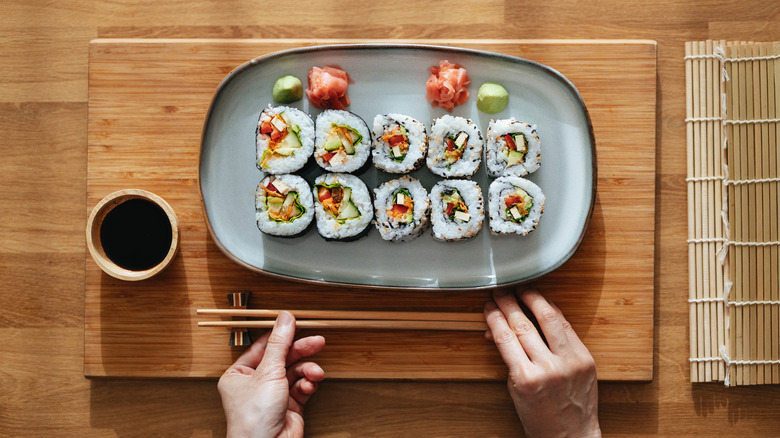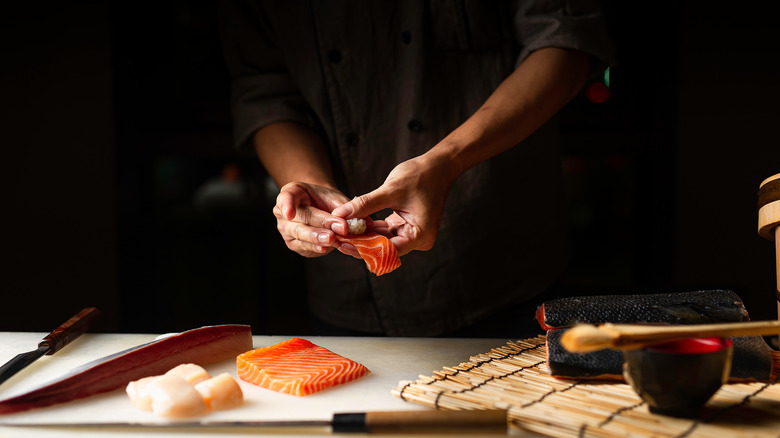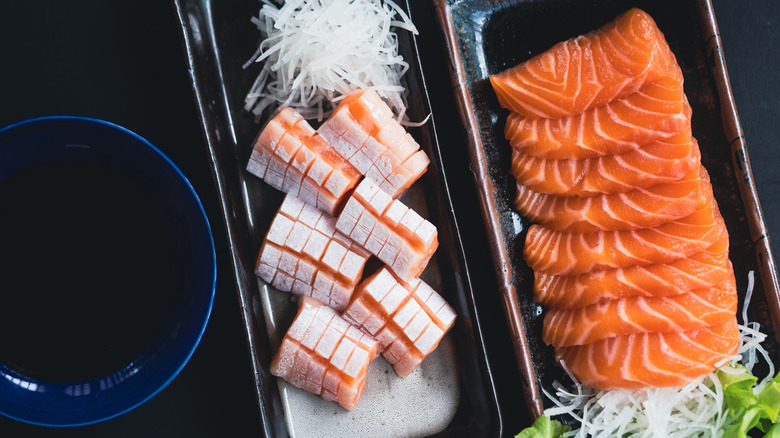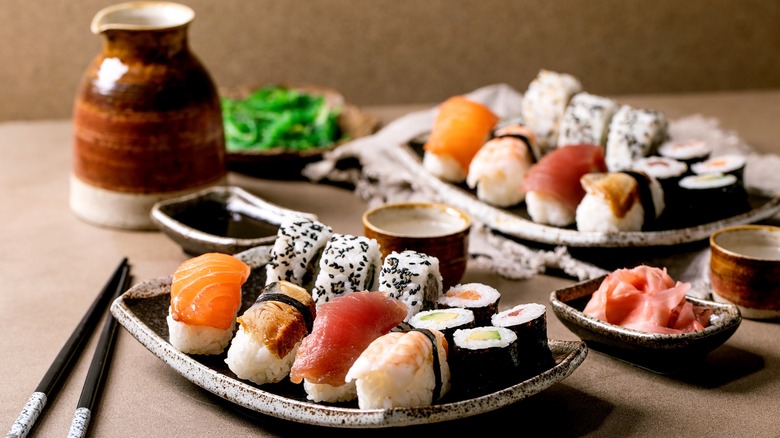How To Handle Soy Sauce At A Sushi Restaurant Like A Pro
Sushi is an art form. These bites or rolls almost always include Japanese short-grained rice that is seasoned with salt, rice vinegar, and sugar, raw or cooked seafood, and sometimes seaweed. Fish and shellfish are most commonly used, though sushi can also be made with tofu, egg, fermented soybean called natto, or different types of fish eggs. Sometimes delicate additions are added which are meant to enhance the flavor of the protein, like shiso (also known as perilla leaf), cucumber, daikon radish, or pickled plum called umeboshi.Regardless, in Japan, sushi is all about letting fresh, high-quality ingredients shine.
Western-style sushi that is loaded with vegetables, tempura shrimp, imitation crab, cream cheese, and lots of sauces can certainly be delicious in its own right, but it is quite a deviation from traditional Japanese sushi which is more about simplicity and technique. While it is common to douse Western-style sushi in spicy mayo, wasabi, and soy sauce, you should not do the same at a classic sushi restaurant. In fact, a representative from Kikkoman told Food Republic that if soy sauce is not offered, it is best not to even ask. If the soy sauce is self-serve, definitely use it in moderation.
Why is it rude to ask for soy sauce?
A sushi chef sometimes undergoes nearly a decade-long apprenticeship, and in the beginning, they are not even allowed to pick up a knife. They start with tasks like cleaning and stocking, and eventually move up to preparing the rice. During this time, the trainee is expected to be observing the techniques of the masters. It takes years for an apprentice to be given the responsibility of preparing fish. Now, imagine taking a piece of sushi that was so perfectly crafted and unabashedly dunking it in soy sauce. It would be an insult. In fact, even asking for soy sauce would be like asking for ketchup for a French omelet or ranch dressing for a pizza Napoletana.
The main rule of thumb here is to trust the chef. A Kikkoman spokesperson told Food Republic, "Bona fide sushi chefs will serve sushi in the way it's meant to be enjoyed. It's best to abide by the experience of the sushi chef — meaning, the soy sauce given to you is the perfect amount intended to complement the flavors of your sushi order."
What do you do with that bottle of soy sauce on the table?
If you are at a more casual establishment where the soy sauce is already on the table, feel free to use it, but do so judiciously. The soy sauce is meant to accent the flavor of the fish, not be the only note you can taste. Traditionally, soy sauce is meant as a light dipping sauce for sashimi — simply served, carefully sliced, raw fish. Dipping a nori-wrapped sushi roll, called makizushi or maki, or a piece of sliced fish over rice, called nigiri, in soy sauce is not always typical.
Food Republic's soy sauce contact at Kikkoman confirms that less is more when it comes to a soy sauce dip, saying, "If it's rolled sushi, pick up the roll and dip one rice side into soy sauce — just a touch. If the sushi piece is rice with fish on top (nigiri), turn it on its side and then dip a bit of the fish into the soy sauce and enjoy." It should be a quick dip because if too much soy sauce is absorbed, it negatively impacts the taste and feel of the rice.
Should you mix soy sauce and wasabi for dipping?
As for the wasabi, it should also be added sparingly. Usually, there is already a bit of wasabi dabbed between the fish and rice in pieces of nigiri. If you are a big wasabi fan, you can add another dot of wasabi on top of the fish. While it is common outside of Japan to mix the wasabi and soy sauce together, this is also a big no-no regarding sushi etiquette. The finesse of the nigiri, sushi roll, or sashimi gets totally lost, and it is impossible to "fully appreciate the flavor of soy sauce and wasabi," notes the Kikkoman representative.
If you simply must soak your sushi in a soy sauce of some sort, do the sushi chef a favor, and dunk away in the privacy of your own home. If you are shelling out the money for good quality sushi and you are unsure of the best way to enjoy the pieces that land on your table, ask your server or sushi chef. Just definitely exercise restraint when you reach for that bottle of soy sauce.




